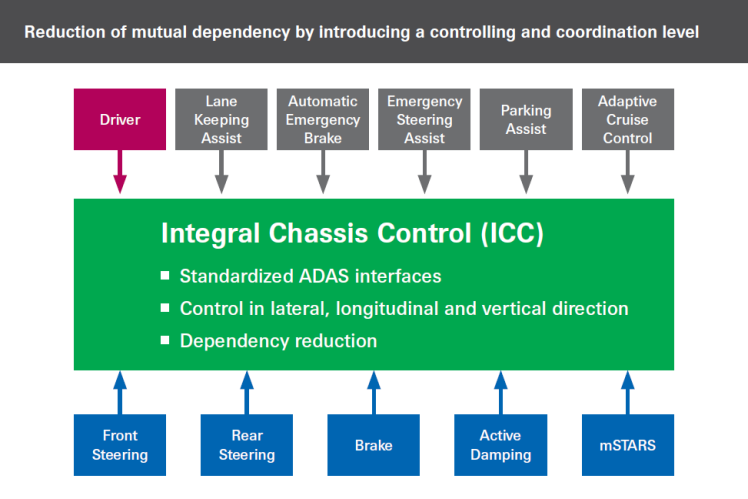New Intelligent Chassis Technology From ZF: Connected Systems Supporting the Vision of Accident-Free Driving - Active chassis systems from ZF are already playing a major role in improving vehicle safety
- New, connected systems that support the driving features of the future
- Integral Chassis Control (ICC) connected to mechatronic systems highlight new chassis functions
The chassis is one of the most complex systems in a vehicle – and one of the most important when it comes to enabling driving safety and comfort. In the age of assisted and autonomous driving features, it will play an increasingly important role and ZF is ideally positioned to support this trend. Its Integral Chassis Control (ICC) connects the individual chassis systems, enabling the ICC to function in the control network and ensure excellent longitudinal, lateral and vertical driving dynamics. Not only is this a plus for safety, but it also prepares the way for autonomous driving features. This is all part of ZF's active contribution to help support the vision of accident-free driving.

The feel of a car on the road is essentially defined by the chassis: Steering, wheel guidance, bearing, damping, suspension, stabilizers and brakes determine the nature of the car. A good chassis can also improve the noise, vibration, harshness (NVH) behavior, helping eliminate the vibrations and noises that drivers and passengers find annoying. ZF is at the top of its game in these areas. “Going forward, mobility will be all about improved driving comfort and safety as well as local zero-emission drives,” says Dr. Holger Klein, head of the Car Chassis Technology Division at ZF Friedrichshafen AG. “So we’ve put a lot of forward thinking into our new active systems to make vehicles ready for autonomous driving features. Because if you’re not actually driving, it may be easy to blame autopilot features for every noticeable pothole or bump in the road.”
sMOTION: Networking that can turn cars into “flying carpets”
The new sMOTION active damping system builds on the proven Continuous Damping Control (CDC) technology from ZF. It is equipped with a motor pump unit integrated into each wheel suspension to enhance shock absorber performance. These bi-directional actuators allow the system to generate forces at a higher speed against the piston rod movement. Consequently, while conventional or semi-active damping systems are sensitive to vibration excitation, sMOTION actively counters roadway surface excitation – such as potholes or bumps – with more kilonewtons of force (scalable). This has the capability to virtually eliminate rolling, pitching, tipping and bounce in the vehicle body. The resulting improvement in body stability helps make driving safer and far more comfortable. “sMOTION makes you feel as if you’re on a flying carpet,” explains Dr. Klein. After all, autonomous driving allows the driver to hand over the vehicle driving functions so that he or she can focus on other activities. If the vehicle becomes a mobile office, for example, the need for comfort becomes more important. Combined with ZF sensors, control electronics, LIDAR or radar, sMOTION will thus support autonomous driving functions.
Stable cornering thanks to Electromechanical Roll Control
ZF's Electromechanical Roll Control (ERC) active roll stabilization system helps to put an end to unwelcome chassis movement that would otherwise affect the car body on bends and uneven road surfaces. The 48 volt electric motor installed on the axle equalizes vehicle roll motion in under 300 milliseconds at torques of up to 1,400 newton meters. The stabilization makes for improved cornering performance and provides a more comfortable ride on uneven road surfaces. What’s more, ERC’s common-component concept makes it suitable for any vehicle category.
More comfort with eLEVEL
ZF’s Electro Hydraulic Leveling (EHL) technology uses four actuators to realign the vehicle’s spring plate, smoothly adjusting the height of the car body. It has a multitude of potential applications and features, including making it easier to get in and out of vehicles, making them more efficient at crossing obstacles and driving uphill, evening out the level of loaded vehicles, optimized vehicle ground clearance with contact-free loading of e-vehicles as well as improved aerodynamics, which in turn reduce CO2 emissions.
Smart networking with Integral Chassis Control
ZF’s Integral Chassis Control (ICC) connects advanced systems such as the electric power steering (EPS) on the front axle to the Active Kinematics Control (AKC) rear wheel steer system, active damping and the vehicle's electronic braking system. Networking the individual actuators creates new functions, such as Emergency Steering and Trailer Stabilization, which balances out unwanted trailer movement. The turning circle as well as vertical motions are also reduced. Together, all of this helps to increase vehicle safety. Last but not least, ICC shifts the dynamic driving limit range outwards to assist the vehicle to stay in its lane even on icy surfaces and, if the situation arises, perform evasive maneuvers more efficiently. Thanks to its actuators and interfaces to the advanced driver assistance systems (ADAS) defined according to the plug-and-play principle, the ICC can be used in a scalable manner, and can thus play a key role in highly automated driving.
- Active chassis systems from ZF are already playing a major role in improving vehicle safety
- New, connected systems that support the driving features of the future
- Integral Chassis Control (ICC) connected to mechatronic systems highlight new chassis functions
The chassis is one of the most complex systems in a vehicle – and one of the most important when it comes to enabling driving safety and comfort. In the age of assisted and autonomous driving features, it will play an increasingly important role and ZF is ideally positioned to support this trend. Its Integral Chassis Control (ICC) connects the individual chassis systems, enabling the ICC to function in the control network and ensure excellent longitudinal, lateral and vertical driving dynamics. Not only is this a plus for safety, but it also prepares the way for autonomous driving features. This is all part of ZF's active contribution to help support the vision of accident-free driving.

The feel of a car on the road is essentially defined by the chassis: Steering, wheel guidance, bearing, damping, suspension, stabilizers and brakes determine the nature of the car. A good chassis can also improve the noise, vibration, harshness (NVH) behavior, helping eliminate the vibrations and noises that drivers and passengers find annoying. ZF is at the top of its game in these areas. “Going forward, mobility will be all about improved driving comfort and safety as well as local zero-emission drives,” says Dr. Holger Klein, head of the Car Chassis Technology Division at ZF Friedrichshafen AG. “So we’ve put a lot of forward thinking into our new active systems to make vehicles ready for autonomous driving features. Because if you’re not actually driving, it may be easy to blame autopilot features for every noticeable pothole or bump in the road.”
sMOTION: Networking that can turn cars into “flying carpets”
The new sMOTION active damping system builds on the proven Continuous Damping Control (CDC) technology from ZF. It is equipped with a motor pump unit integrated into each wheel suspension to enhance shock absorber performance. These bi-directional actuators allow the system to generate forces at a higher speed against the piston rod movement. Consequently, while conventional or semi-active damping systems are sensitive to vibration excitation, sMOTION actively counters roadway surface excitation – such as potholes or bumps – with more kilonewtons of force (scalable). This has the capability to virtually eliminate rolling, pitching, tipping and bounce in the vehicle body. The resulting improvement in body stability helps make driving safer and far more comfortable. “sMOTION makes you feel as if you’re on a flying carpet,” explains Dr. Klein. After all, autonomous driving allows the driver to hand over the vehicle driving functions so that he or she can focus on other activities. If the vehicle becomes a mobile office, for example, the need for comfort becomes more important. Combined with ZF sensors, control electronics, LIDAR or radar, sMOTION will thus support autonomous driving functions.
Stable cornering thanks to Electromechanical Roll Control
ZF's Electromechanical Roll Control (ERC) active roll stabilization system helps to put an end to unwelcome chassis movement that would otherwise affect the car body on bends and uneven road surfaces. The 48 volt electric motor installed on the axle equalizes vehicle roll motion in under 300 milliseconds at torques of up to 1,400 newton meters. The stabilization makes for improved cornering performance and provides a more comfortable ride on uneven road surfaces. What’s more, ERC’s common-component concept makes it suitable for any vehicle category.
More comfort with eLEVEL
ZF’s Electro Hydraulic Leveling (EHL) technology uses four actuators to realign the vehicle’s spring plate, smoothly adjusting the height of the car body. It has a multitude of potential applications and features, including making it easier to get in and out of vehicles, making them more efficient at crossing obstacles and driving uphill, evening out the level of loaded vehicles, optimized vehicle ground clearance with contact-free loading of e-vehicles as well as improved aerodynamics, which in turn reduce CO2 emissions.
Smart networking with Integral Chassis Control
ZF’s Integral Chassis Control (ICC) connects advanced systems such as the electric power steering (EPS) on the front axle to the Active Kinematics Control (AKC) rear wheel steer system, active damping and the vehicle's electronic braking system. Networking the individual actuators creates new functions, such as Emergency Steering and Trailer Stabilization, which balances out unwanted trailer movement. The turning circle as well as vertical motions are also reduced. Together, all of this helps to increase vehicle safety. Last but not least, ICC shifts the dynamic driving limit range outwards to assist the vehicle to stay in its lane even on icy surfaces and, if the situation arises, perform evasive maneuvers more efficiently. Thanks to its actuators and interfaces to the advanced driver assistance systems (ADAS) defined according to the plug-and-play principle, the ICC can be used in a scalable manner, and can thus play a key role in highly automated driving.
MEDIA
CONTACT

Robert Buchmeier

